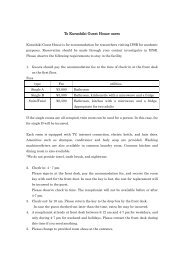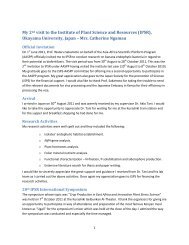Institute of Plant Science and Resources
Institute of Plant Science and Resources
Institute of Plant Science and Resources
Create successful ePaper yourself
Turn your PDF publications into a flip-book with our unique Google optimized e-Paper software.
VIII<br />
Research Core for <strong>Plant</strong> Stress <strong>Science</strong><br />
<strong>Plant</strong> stresses are classified into three major factors as described below. Research units<br />
corresponding to respective stress factors carry out collaborative studies. In each unit,<br />
plant stress responses <strong>and</strong> plant interactions with other organisms are studied using<br />
various approaches <strong>of</strong> physiology, biochemistry, pathology, <strong>and</strong> genetics. Barley <strong>and</strong> wild<br />
plant germplasm collected at the institute will be used effectively to develop stresstolerant<br />
crop plants.<br />
Atmospheric Stress Unit<br />
Under atmospheric environments, fluctuations <strong>of</strong> light intensity, temperature, or<br />
humidity can significantly reduce plant growth <strong>and</strong> ultimately affect the crop yield. To<br />
acclimate to such atmospheric stresses, plants have evolved various ways by which<br />
growth defects can be minimized. The atmospheric Stress Research Unit specifically<br />
examines light stress on photosynthetic apparatus in chloroplasts, response to oxidative<br />
stress caused by reactive oxygen species, <strong>and</strong> roles <strong>of</strong> a phytohormone––abscisic acid––<br />
during drought, <strong>and</strong> aim at underst<strong>and</strong>ing the mechanism(s) that enable plants to tolerate<br />
atmospheric stresses at the molecular level. Combined with the use <strong>of</strong> available genetic<br />
resources, our research will facilitate engineering <strong>of</strong> crops that are acclimated to the<br />
atmospheric stresses.<br />
Soil Stress Unit<br />
Problem soils including acid, alkaline, salt <strong>and</strong> heavy-metal contaminated soils<br />
comprise approximately 70% <strong>of</strong> world’s arable soils. Because <strong>of</strong> deficiency <strong>and</strong>/or excess<br />
<strong>of</strong> minerals, the productivity <strong>and</strong> quality <strong>of</strong> crops on these soils are low. Drought<br />
(shortage <strong>of</strong> soil water) is also a major limiting factor for crop production. It is a key to<br />
enhancing crop productivity <strong>and</strong> to improving crop product safety on problem soils to<br />
solve future shortage problems related to foods <strong>and</strong> fuels. In this unit, we specifically<br />
examine the response <strong>and</strong> tolerance mechanisms <strong>of</strong> plants to problem soil stresses such as<br />
drought, salt, aluminum toxicity, iron deficiency, heavy metals, etc. Our goal is to breed<br />
crops with increased productivity <strong>and</strong> safety on problem soils.<br />
Biotic Stress Unit<br />
<strong>Plant</strong>s are exposed to various biotic stresses in the environment. They are exemplified<br />
by infectious pathogens such as viruses, bacteria <strong>and</strong> fungi, <strong>and</strong> destructive insects. By<br />
contrast, numerous microorganisms support the healthy growth <strong>of</strong> plants, e.g., those<br />
infecting plant pathogens to attenuate their virulence, soil-borne organisms that are<br />
mutualistic to plants, <strong>and</strong> beneficial microorganisms residing on the aerial parts <strong>of</strong> plants.<br />
The ultimate goal <strong>of</strong> this unit is to achieve “Healthy <strong>Plant</strong> Growth.” To attain this goal,<br />
we study plant responses to organisms that are influential to plant growth; we also study<br />
the molecular mechanisms <strong>of</strong> their effects, which enhances a better underst<strong>and</strong>ing <strong>of</strong> the<br />
dynamic interactions that occur among organisms affecting plants <strong>and</strong> those that occur<br />
between plants <strong>and</strong> organisms.




![[Application Forms to Tenure-track Assistant Professor] Applicants ...](https://img.yumpu.com/36047313/1/184x260/application-forms-to-tenure-track-assistant-professor-applicants-.jpg?quality=85)






